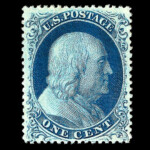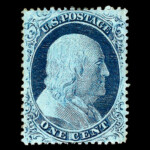Scott #6, a member of the early United States postage stamp series, exhibits a unique historical significance. It is part of a broader series of stamps that were used during a pivotal period in the American postal system. The stamp is noted for its specific design, classified as Type Ia. This design is characterized by a complete presentation of bottom and side ornaments, while the top ornaments are partially omitted, a result of the manufacturing process. The stamp was intended for general postal use, adhering to the postal rates and regulations of the time. Among its varieties, Scott #6 is known for its imperforate version, which is significantly rarer compared to its perforated counterpart, Scott #19.
Design & Print
The production of Scott #6 was a task undertaken in the year 1857, specifically during the months of April, May, and June. This stamp is a representation of the Type Ia design, coming exclusively from 18 of the 20 positions on the bottom row of Plate 4. Plate 4 itself is notable for its usage in stamp production, both before and after the introduction of perforations in stamps. The design of Scott #6 includes a denomination that aligns with the postal rates of the era. Postal Usage
In the context of its postal utility, Scott #6 was utilized in alignment with the postal rates and regulations prevailing in the mid-19th century. The denomination of the stamp was set to correspond with the standard postal rates for letters and correspondences during that period. The introduction of Scott #6 came at a transitional time in the postal system, marked by the shift from imperforate to perforated stamps. This transition reflects broader changes in the postal system, including modifications in postal rates and the implementation of new postal laws and regulations. Scott #6 served a functional role in this evolving landscape of postal services.
Identification
Identifying Scott #6 requires attention to several specific design characteristics. As a Type Ia design, the stamp is distinct in its complete display of bottom and side ornaments and the partial display of top ornaments. A notable feature for identification is the broken curved line at the top, although some variations show a blurred burr in this area, which can initially give the impression of an unbroken line. The stamp’s identification is further complicated by the similarities it shares with other stamps in the series, necessitating a careful examination of these specific features for accurate classification.
Scott #6 is not merely a postage stamp; it is a window into a specific era of postal history in the United States. Its design, production, usage, and identification are intertwined with the technological and regulatory developments of the time. Understanding Scott #6 requires an appreciation of these multifaceted aspects, each contributing to its place in the annals of philatelic history.















































Ask A Question Or Leave A Comment